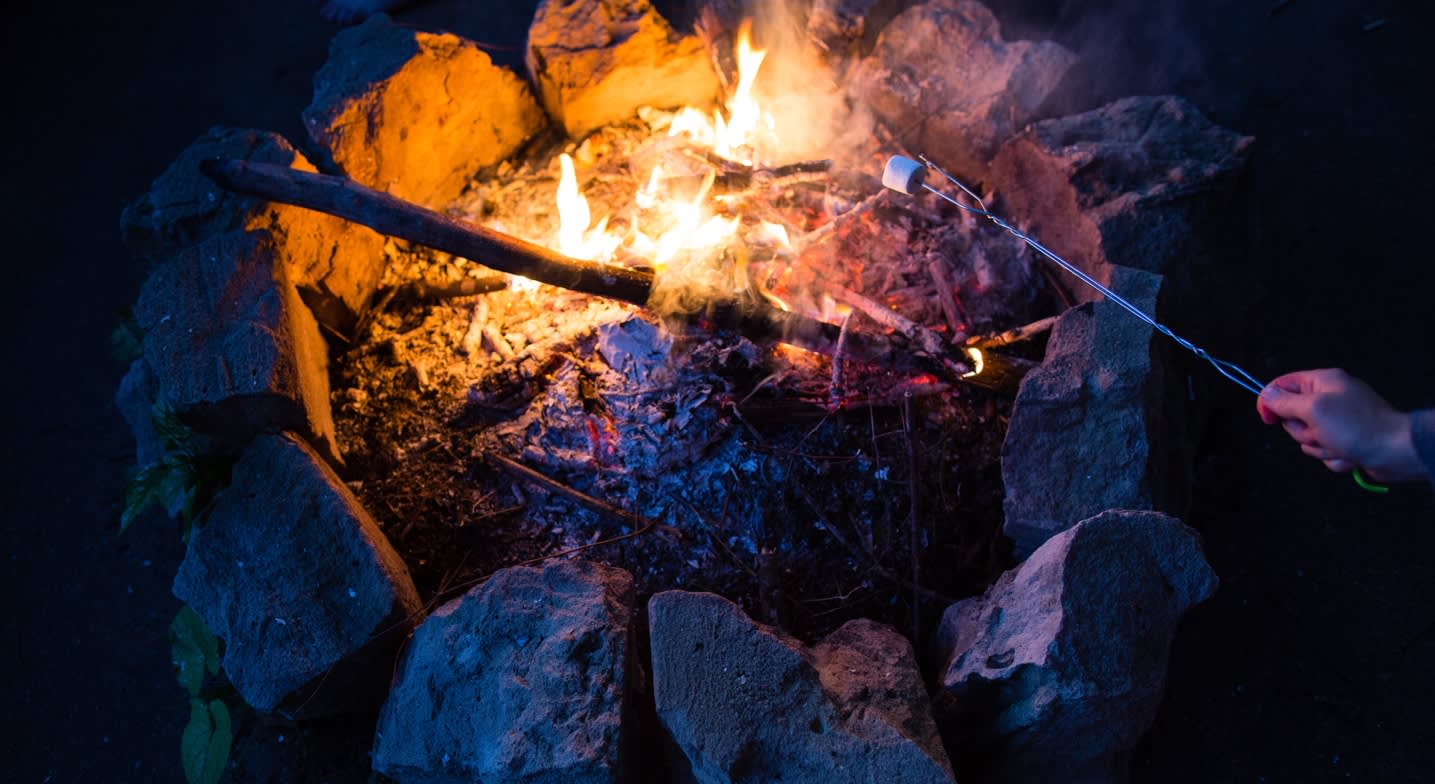H.P. Lovecraft, the enigmatic master of literary horror, once wrote, “The oldest and strongest emotion of mankind is fear, and the oldest and strongest kind of fear is fear of the unknown.” It’s for this reason that we love scary stories. They enable us to safely explore our age-old emotional nemeses and to thrill ourselves with them. The most effective tales of the macabre exploit the natural high we experience when tapping into our primitive fight-or-flight response. No setting is better for achieving this effect than the hypnotic glow of a campfire.
“Sitting in a limited circle of illumination, surrounded by darkness and whatever might be hiding in it, provides an interesting combination of comfort and exposure,” says Mathias Clasen, an assistant professor in literature and media at Denmark’s Aarhus University. “The dark embodies the unknown, so campfires make it easy to sensitize the audience to danger and to spook them.”
Since first learning to master fire around 400,000 years ago, we have become one of the few species that is not afraid of it — and is even drawn to it. “I think there is something about the fire itself that attracts us, though there’s been very little research into the psychology of fire and the fascination it commands,” says Clasen. It’s impossible to know when the tradition of telling scary stories around the campfire began, but there is evidence that fire and storytelling have gone hand in hand for thousands of years.
We are naturally drawn to tales ridden with problems, challenges, and dangers — horror nicely fits that bill.
According to a 2014 analysis of interviews conducted in the 1970s with Namibia and Botswana’s Ju/’hoansi people — who were then then living as hunter-gatherers — 81 percent of fireside chats were devoted to storytelling. Daytime conversations, on the other hand, largely dealt with mundane, practical matters. Polly Wiessner, the study’s author and an anthropologist at the University of Utah, suspects that nocturnal storytelling allowed us to better relate to one another and to develop richer cultures.
Those activities also bestowed us with a deep-rooted fondness for sitting around the campfire. As Wiessner writes: “Appetites for firelit settings for intimate conversation and for evening stories remain with us today.” Still other studies have found that campfires induce relaxation and lower blood pressure and that evolution has uniquely adapted us to more safely deal with pollutants produced by a campfire’s smoke.
Over the years, stories themselves have evolved as well, becoming more sophisticated, nuanced, and effective. We are naturally drawn to tales ridden with problems, challenges, and dangers, and horror nicely fits that bill. “Ghost stories often present real, existential threats to the protagonists of the story, since they might get killed,” says Jonathan Gottschall, a distinguished fellow at Washington & Jefferson College and author of The Storytelling Animal: How Stories Make Us Human. “They tap into truly primal fears of ours, including our massive dread of the mystery of what happens to us when we die.” As such, horror stories are likely universal and timeless. “People in various cultures — most cultures and possibly all cultures — have scared themselves, at least partly voluntarily, since human societies with language capabilities developed,” writes historian Peter N. Stearns in American Fear.
The appetite for horror arises at a young age, says Clasen; kids are fascinated with playing hide-and-seek, hearing about monsters, and expanding their boundaries through fiction and play. Of all the age groups, however, it’s young adults — 16 to 25 years old — who generally harbor the largest fondness for horror. “At that age, people are biologically disposed to doing really stupid things and focused on pushing and testing their boundaries,” says Clasen. “They want to prove themselves and secure their place in hierarchies, which can be done by exhibiting mastery when watching horror films with a group.”
Margee Kerr, a sociologist at the University of Pittsburgh and author of Scream: Chilling Adventures in the Science of Fear, adds that, in some cases, horror stories provide us with a means to face and conquer our fears. “We know we’re safe, that we’re not facing any real threat, yet we can allow ourselves to suspend our disbelief and then reap the benefits of overcoming danger,” she says.
Very young children, however, have difficulty differentiating fact from fiction and therefore struggle with a crucial prerequisite for enjoying scary stories: knowing that they are not real. This, says Clasen, is why we do not delight in having nightmares; even though they structurally resemble scary films, we feel that the situation is real and that we have no control over it.
Older people also avoid horror, possibly because they have more difficulty coping with excessive stress hormones, says Clasen, or simply because they no longer fall for tired storylines. “Frustratingly, we don’t really know the answers to these questions because so little empirical research has been conducted in the domain of horror,” he says.
Regardless of age, though, a subset of people — about a quarter of the population, according to Clasen’s research — seems not to enjoy horror under any circumstances. Studies need to be done to fully understand this, but preliminary, unpublished data indicate that a strong dislike of horror may be linked to an individual’s degree of neuroticism (their sensitivity to negative stimuli). Those whose personalities are at extreme ends of the neuroticism spectrum — that is, those for whom negative stimuli either causes a very strong reaction or no reaction at all — will likely be the ones who do not enjoy scary stories: At one end are people who are too terrified to find any pleasure in them, while people on the other end of the spectrum will be bored.
But for the majority of people who do enjoy horror, the campfire provides a unique setting for feeding an insatiable fascination with the disturbing, disgusting, and terrifying. The presence of other people in that setting is a plus, says Kerr, as it gives us a sense of solidarity and unity. The group can also enhance the story’s effectiveness, since emotions are contagious. “You can have great social bonding in this space where everyone’s attention is focused on the same thing,” she says. “You can see the expressions on their faces or grab your neighbor’s hand.”
“The story kind of seems disembodied — like it’s just coming out of the blackness — and this disinhibits the teller and the audience.”
Gottschall adds that staring into a fire may produce a blinding effect — or at least something visually alluring to focus on — that likely allows story listeners to sink even deeper into the tale. “The awkwardness of eye contact is taken away,” he says. “The story kind of seems disembodied — like it’s just coming out of the blackness — and this disinhibits the teller and the audience.”
The darkness surrounding the campfire’s comforting glow, of course, is also an asset for setting us on edge. Historically, we had cause to fear predators that may lurk in the inky black. Ghost stories simply replace those age-old fears with monsters, serial killers, and the supernatural. As Kerr says: “It just wouldn’t be the same if you were sitting inside around a kitchen table.”
The flames of this time-honored tradition may be flickering out, however. Adults and children alike are spending less time outdoors, and oral transmission of stories has largely been replaced by movies, television, and video games. “But sitting across from someone, seeing the shadows and light play on their face and hearing them tell a story about some creepy event — that’s an experience that is quite distinct from watching a horror film,” says Clasen. “I hope things like summer camps with counselors and bonfires will keep the tradition alive.”







